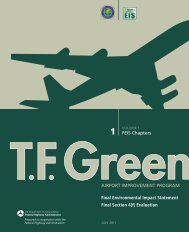Ch 2 Precision Approach Feasibility - PVD
Ch 2 Precision Approach Feasibility - PVD
Ch 2 Precision Approach Feasibility - PVD
You also want an ePaper? Increase the reach of your titles
YUMPU automatically turns print PDFs into web optimized ePapers that Google loves.
North Central State Airport<br />
<strong>Ch</strong>apter 2 – <strong>Precision</strong> <strong>Approach</strong> <strong>Feasibility</strong><br />
Airport Master Plan<br />
FINAL<br />
enough that improving the approach capabilities with lower minimums also enhances the level of safety<br />
when the pilot needs it most. As an added measure of safety, many pilots will fly an instrument approach<br />
during visual, good weather conditions. RIAC receives frequent inquiries and requests by pilots for reduced<br />
minimums, which further enhances the justification for pursuing an LPV at SFZ. It’s a “catch 22” situation.<br />
FAA is prepared to do the Survey, but not address the clearing requirements. The clearing will be the<br />
responsibility of RIAC and it is eligible for AIP reimbursement.<br />
2.2.2 Design Standards<br />
Although site requirements typically required for an ILS are unnecessary with an LPV approach,<br />
compliance with the design standards of Advisory Circular 150/5300-13 “Airport Design” still is required.<br />
Since the LPV approach may improve the existing capability, the airport infrastructure may require<br />
upgrading to accommodate the potential for increased activity by larger more complex aircraft. For this<br />
reason, a “table-top” evaluation was performed to determine if further actions, such as land acquisition,<br />
obstacle clearing, and upgrading airfield geometry and runway markings are required to achieve the full<br />
benefit of the LPV procedure. Once the scope of the infrastructure needs and costs are understood,<br />
informed decisions on the feasibility of implementing an LPV approach, along with options for funding can<br />
be realized.<br />
A review of the primary design standards was conducted under the premise that if and when SFZ<br />
implements an LPV approach, the increased usage of larger or complex aircraft may cause the airport to<br />
change from the current ARC B-II design standard to the expanded ARC C-II design requirements. Table<br />
2.3 shows the comparison between the existing airport conditions and the C-II design standard. To<br />
accommodate the difference would require capital improvements to bring the airfield up to the C-II<br />
standard.<br />
Table 2.3<br />
SFZ Design Standards (Current vs. C-II)<br />
Design Standard Existing (ft) C-II (ft) Deficit (ft)<br />
Runway CL to Taxiway CL 350 400 (50)<br />
Runway CL to Aircraft Parking 420 500 (80)<br />
Runway Width 100 100 Meets Reqt.<br />
RSA Width 500 500 Meets Reqt.<br />
RSA Length – 5 End 300 1,000 (700)<br />
RSA Length – 23 End 300 1,000 (700)<br />
OFA Width 500 800 (300)<br />
OFA Length 300 1,000 (700)<br />
RPZ Runway 5<br />
IW- 1,000<br />
OW- 1,510<br />
L- 1,700<br />
IW- 1,000<br />
OW- 1,750<br />
L- 2,500<br />
IW- 0<br />
OW- (240)<br />
L- (800)<br />
There is no evidence in the forecast (<strong>Ch</strong>apter 3), suggesting that the airport activity level for the higher<br />
performance aircraft (C-II) would dramatically increase because of the LPV. Nonetheless, if the design<br />
aircraft of the airport were to change, requiring C-II design standards; the costly investment in airport<br />
infrastructure needs to be understood now. These investments include, but are not limited to:<br />
Rhode Island Airport Corporation<br />
The Louis Berger Group, Inc. March 2010 - Page 2-6















